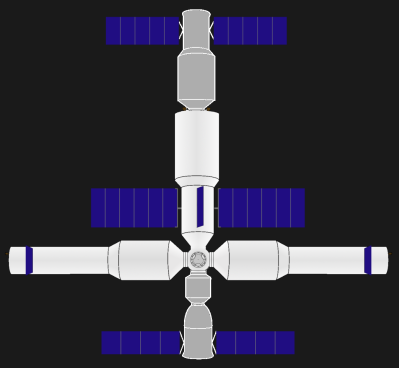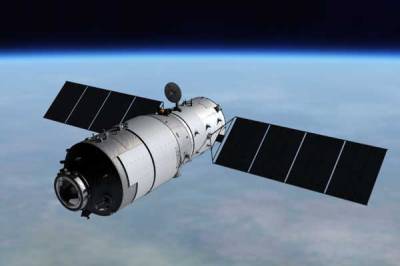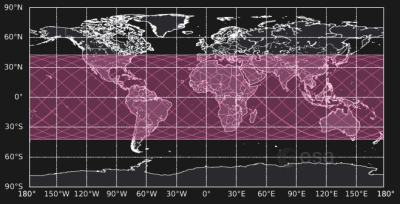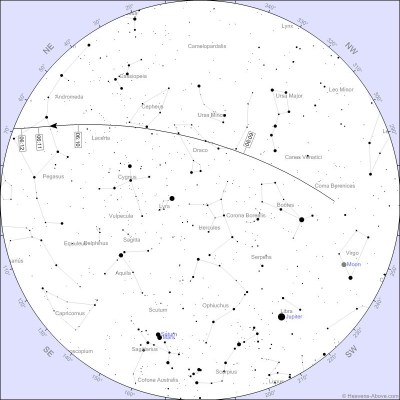China’s first space station, Tiangong-1, is expected to do an uncontrolled re-entry on April 1st, +/- 4 days, though the error bars vary depending on the source. And no, it’s not the grandest of all April fools jokes. Tiangong means “heavenly palace”, and this portion of the palace is just one step of a larger, permanent installation.
But before detailing just who’ll have to duck when the time comes, as well as how to find it in the night sky while you still can, let’s catch up on China’s space station program and Tiangong-1 in particular.
China’s Space Station Program

The space station that is currently on it way back to earth is a stepping stone in China’s long-range space station plan. They are on track to put up a permanent modular space station by 2022 with the first module going up in 2019. It’s to be around the size of the Russian Mir space station and have a ten-year design life. Central to it will be a service module with multiple docking ports and an EVA hatch. Permanently attached to that will be two lab modules. Crewed Shenzhou spacecraft and uncrewed Tianzhou resupply ships will be able to dock as needed.
However, before building the permanent station, they first had to test various technologies. In September 2011, China launched the Tiangong-1 space laboratory, followed in September 2016 by the Tiangong-2. These preliminary steps are much like Russia took with their Salyut space station program.
Both Tiangong-1 and 2 are first generation space stations in that they are single pieces with only one docking port. Having only one docking port means that they cannot be resupplied while a crew is present. That’s because the only docking port would already have a spacecraft attached to it as a lifeboat. A second-generation space station is also a single piece but with two docking ports, allowing for mid-mission resupplies and longer missions. The Chinese permanent space station will be a third generation, defined as a design consisting of multiple modules.
Tiangong-1

The 8,500 kg (18,750 lb) Tiangong-1 was both a prototype space station and a space laboratory. As a prototype, it served primarily to test orbital rendezvous and docking. It’s made up of two cylindrical sections, a resource section with propulsion systems and solar panels, and a habitable section.
The habitable volume is 15 m3 (530 ft3) and includes control, communication and entertainment systems, exercise equipment, and two sleeping stations. A third crew member sleeps in the Shenzhou spacecraft in which they arrived. Cooking and toilet facilities are also in the Shenzhou.
The Missions

Tiangong-1 had a two-year operational life during which three Shenzhou spacecraft docked to it. The first, the unmanned Shenzhou 8, successfully rendezvoused and docked in November 2011. The second, Shenzhou 9, followed on June 18, 2012, carrying a crew of three.
The initial docking of Shenzhou 9 was performed under automated control but six days later the crew performed another test by undocking and then redocking manually. The experiments were oriented around crew health and the effects of microgravity. They returned to Earth on June 29.
Shenzhou 10 carried three more crew the following year on June 11, 2013. They carried out further science and technical experiments, more docking tests, and did space station maintenance by replacing interior cladding and working on the seal rings. The crew also gave a video lecture and microgravity demonstrations to students throughout China. The mission lasted 15 days.
After the Shenzhou 10 mission, the station was put into sleep mode to save power while monitoring continued in order to test the longevity of key materials before its eventual re-entry.
Uncontrolled Re-entry
As stated above, Tiangong-1 is expected to re-enter the Earth’s atmosphere on April 1st +/- 4 days. The majority of Tiangong-1 is expected to burn up in the upper atmosphere, however, some pieces may reach the Earth’s surface.
Often in such case, the re-entry trajectory is guided so that those pieces come down in unpopulated areas. When the Russian Mir space station was deorbited in 2001, Russia used a Progress cargo spaceship to make sure it re-entered over the Pacific ocean. In March 2016, China announced that it had ceased data services for Tiangong-1 but also that it was under continued and close monitoring. However, according to ESA’s blog, there’s speculation that the station had ceased functioning and that ground crews no longer had the ability to command its engines to fire, hence, Tiangong-1 will undergo an uncontrolled re-entry.
Where The Debris Will Fall

Any debris will fall between latitudes 43° North and 43° South. But fear not, according to the IADC (Inter-Agency Space Debris Coordination Committee) anyone living in that area is 10 million times more likely to be struck by lightning than by any debris.
When You Can See It In Your Sky

Before it re-enters, there may still be time to see it in the night sky and there are plenty of websites which tell you when and where to look. With no particular preference other than that it’s easy to use and does the job, here’s a link to heavens-above.com. In its list, click on “Change your observing location” to tell it where you are, and then click on “Home” to get the list again. Next, click on “Tiangong-1”. If you’re lucky enough to be in an area where it’ll be visible then you’ll see a list of viewing times. Click on one of the dates for a star chart telling you where to look at that time. Hopefully, it won’t reenter before March 31st because my next viewing opportunity is in the southern sky between 6:05 AM and 6:07 AM that morning.
If you have your own favorite viewing website or even a phone app, please share it with us in the comments below. And be sure to let us know if you do see it, or if you see the fireballs streaking across the sky on the day.
















I’ll just put this here…
Latest prediction is April 1st, 10:30UTC +/- 16 hours.
(Refresh for latest updates)
http://www.aerospace.org/CORDSuploads/TiangongStoryboard.png
Thanks Lucas…this shows the flight path goes over Kentucky where I am…or at least, fairly close. Your post is very helpful.
Kentucky?
Oh man, how awesome could this be?
http://alturl.com/upkmt
I’m assuming this is not your home @PirateLabs, no ill will meant towards you
No, that’s like 4 hours or more north of me. I live where the Corvettes are assembled and where John Carpenter used to live and where the film Halloween was based upon.
Is radar data accurate to 0.01mm or someone had fun with floats ?
Definitely isn’t…the radars that are used to track these are the same as the early warning radars (they mostly look for incoming ICBMs, but they are used part-time for debris tracking), they work in UHF bands, so the error is 10s of cm at least…
Looks like in laser rangefinder data then, still very impressive on moving target 180km away thru gas mix blanket.
Is that the DEW line and other radar lines further south in latitude? I’ve read they have FAA operations also if so.
The DEW line is largely a thing of the past and it really isn’t using missile tracking radar it is probably being tracked by this https://en.wikipedia.org/wiki/Eglin_AFB_Site_C-6 and other sites.
Has anybody done the math on percent ocean versus percent land and percent populated land versus unpopulated land?
This is clearly not going to fully burn up during reentry but it is also considerably most likely to just land in the ocean anyway, right?
Just ran the numbers, 97% chance it lands in your yard. Congrats!!
Whoo Hoo! But then I have a VERY big backyard.
Look at the impact probability graph
http://blogs.esa.int/rocketscience/files/2018/01/esa_esoc_tiangong1_risk_map_jan2018-1024×375.png
That graph makes no sense. It probably doesn’t include the ocean. And the units on the right histogram are also wrong. It would have to be %/km or something. It’s not corrected for bin size.
So the ESA have it wrong ? Could you explain further ?
It makes sense and it includes the ocean. You are correct that the units are missing for the vertical axis and the horizontal axis units would be better labeled as %/degree r %/km, but since the total area of the graph needs be 100%, it isn’t ambiguous. It LOOKS weird since the probability at max an min latitude is much greater than in the mid latitudes due to the orbit (well, it would be the same for any near circular orbit that isn’t purely equatorial or near polar, though this is about the most extreme choice)
Yes, I had to look several times, but I have seen a lot (too many) of probability density graphs similarly labelled.
That’s not really possible due to non-homogeneous distribution of people. Assuming 1 person /km² in this area and a killzone of 10 m² (it’s really just going to be a few parts that will be deadly), 10 µPersons will be killed on average. Seems not worth the hubub, considering that flu kills a few thousand every year.
real time
http://www.satflare.com/track.asp?q=37820#TOP
Awesome site…thanks.
There are a few great tracking sites with predicted paths of reentry, here is a start:
http://www.satflare.com/track.asp?q=37820#TOP
That is awesome! I am so enthused :D
It’s unlikely to be April 1 – 4 days at this point…
Respect for the Chinese space program. Really incredible how much progress they’ve made in so little time.
Oh, they’ve stood on the shoulders of giants, stealing US and Russian technology.
Standing on the shoulder of giants is the best way of capturing satellites.
Not only hacking satellites out, shooting down with missiles and the latest with lasers.
OR launching satellites, for that matter. The Chinese were quite suave in that aspect.
I wonder if this was a planned target date… just in case task planning for timing since there are still gaps in calculations or confidence on their end regarding trajectories as seems rather loose.
I am listing a genuine piece of debris from the Tiangong-1 on ebay. How high should I set the BIN price?
Eighty nine cents but it will take 3 weeks to put it in an envelope and 8 weeks to get there and then just send some Vietnam era transistor with all the nomenclature buffed off.
That way people will know it is real Chinese goods ;)
This fools day for the sky falling on me.
I figure the Chinese space station designers are really down to earth guys.
Speaking of something else the Chinese are doing.
http://www.sciencemag.org/news/2018/03/x-ray-ghost-images-could-cut-radiation-doses
I bet this could be used for other things as well.
I was at school when it was raining american space stations.
A well-known Australian entrepreneur offered a $20 million SkyLab insurance in case it dropped on our heads. And sure enough it did, in a way, as it crashed in Western Australia :)
I was at school when it was raining Russian space stations. Kosmos 954 rained down radioactive debris in northwestern Canada back in 1978.
Yes I remember that too but I recall it was a satellite not a multi-ton manned space station.
…Legend has it that Skylab debris killed a rabbit.
Did the USA ever pay the fine for littering that Australia sent?
And Saturday Night Live had fun with the idea that the radioactive debris caused lobsters to grow to the size of helicopters.
Free space station limit one? I wonder why the ground crew lost control, and uh what frequency a control/comms link would be.
2232.15 mhz:
https://www.rtl-sdr.com/receiving-chinese-space-station-tiangong-1-rtl-sdr/
Raise your hand if you remember Skylab falling out of orbit. I watched the Miss Universe Pageant that year to see the chunk of it they displayed on the show.
Yea, I remember that, my being older than time. (unix time that is :-) ) Australians have all the fun. ????
1522623844
Blast, SDR only goes up to 2.0000 GHz.
Maybe try a downconverter?
RTL-SDR is not the only SDR available. HackRF1 and Rad1o go up to 5 or 6 GHz.
Vote for renaming the satelite “Jesus 2” As it comes back to earth on eatster.
Makes me want to watch the end of that movie “Gravity” for a dramatization of the station entering the atmosphere.
Shame we won’t get a view like that :(
Latest update: it came down at about 8:15 PM EDT April 1 and supposedly came down in Pacific ocean north of the famous space graveyard.
Thanks!,
I kept forgetting to check today for updates.
In fact, this is not even news. Objects are falling from space every month. Last month a Russian part fell on Corsica, Italy. Now the word ‘space station’ is used, everybody is suddenly excited.